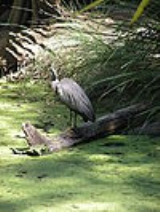
Great-billed Heron
Encyclopedia
The Great-billed Heron, Ardea sumatrana is a wading bird of the heron
family, Ardeidae, resident from southeast Asia
to Papua New Guinea
and Australia
. Its habitats are largely coastal such as islands, coral reefs, mangroves, large rivers. However, occasionally, it can be found inland in shallow ponds.
It feeds in shallow water, spearing fish
with its long, sharp bill. It will wait motionless for prey, or slowly stalk its victim.
The Great-billed Heron is a large bird, standing 115cm tall. It is larger than the Purple Heron
, which it resembles in appearance, although it is larger and darker. The plumage
is largely dark grey above. In flight, it has a uniform dark grey upperwing.
The flight is slow, with its neck retracted. This is characteristic of herons and bittern
s, and distinguishes them from stork
s, crane
s and spoonbill
s, which extend their necks.
Widespread throughout its large range, the Great-billed Heron is evaluated as Least Concern on the IUCN Red List
of Threatened Species.
Heron
The herons are long-legged freshwater and coastal birds in the family Ardeidae. There are 64 recognised species in this family. Some are called "egrets" or "bitterns" instead of "heron"....
family, Ardeidae, resident from southeast Asia
Southeast Asia
Southeast Asia, South-East Asia, South East Asia or Southeastern Asia is a subregion of Asia, consisting of the countries that are geographically south of China, east of India, west of New Guinea and north of Australia. The region lies on the intersection of geological plates, with heavy seismic...
to Papua New Guinea
Papua New Guinea
Papua New Guinea , officially the Independent State of Papua New Guinea, is a country in Oceania, occupying the eastern half of the island of New Guinea and numerous offshore islands...
and Australia
Australia
Australia , officially the Commonwealth of Australia, is a country in the Southern Hemisphere comprising the mainland of the Australian continent, the island of Tasmania, and numerous smaller islands in the Indian and Pacific Oceans. It is the world's sixth-largest country by total area...
. Its habitats are largely coastal such as islands, coral reefs, mangroves, large rivers. However, occasionally, it can be found inland in shallow ponds.
It feeds in shallow water, spearing fish
Fish
Fish are a paraphyletic group of organisms that consist of all gill-bearing aquatic vertebrate animals that lack limbs with digits. Included in this definition are the living hagfish, lampreys, and cartilaginous and bony fish, as well as various extinct related groups...
with its long, sharp bill. It will wait motionless for prey, or slowly stalk its victim.
The Great-billed Heron is a large bird, standing 115cm tall. It is larger than the Purple Heron
Purple Heron
The Purple Heron is a wading bird in the heron family Ardeidae, breeding in Africa, central and southern Europe, and southern and eastern Asia. The European populations are migratory, wintering in tropical Africa; the more northerly Asian populations also migrate further south within Asia...
, which it resembles in appearance, although it is larger and darker. The plumage
Feather
Feathers are one of the epidermal growths that form the distinctive outer covering, or plumage, on birds and some non-avian theropod dinosaurs. They are considered the most complex integumentary structures found in vertebrates, and indeed a premier example of a complex evolutionary novelty. They...
is largely dark grey above. In flight, it has a uniform dark grey upperwing.
The flight is slow, with its neck retracted. This is characteristic of herons and bittern
Bittern
Bitterns are a classification of birds in the heron family, Ardeidae, a family of wading birds. Species named bitterns tend to be the shorter-necked, often more secretive members of this family...
s, and distinguishes them from stork
Stork
Storks are large, long-legged, long-necked wading birds with long, stout bills. They belong to the family Ciconiidae. They are the only family in the biological order Ciconiiformes, which was once much larger and held a number of families....
s, crane
Crane (bird)
Cranes are a family, Gruidae, of large, long-legged and long-necked birds in the order Gruiformes. There are fifteen species of crane in four genera. Unlike the similar-looking but unrelated herons, cranes fly with necks outstretched, not pulled back...
s and spoonbill
Spoonbill
Spoonbills are a group of large, long-legged wading birds in the family Threskiornithidae, which also includes the Ibises.All have large, flat, spatulate bills and feed by wading through shallow water, sweeping the partly opened bill from side to side...
s, which extend their necks.
Widespread throughout its large range, the Great-billed Heron is evaluated as Least Concern on the IUCN Red List
IUCN Red List
The IUCN Red List of Threatened Species , founded in 1963, is the world's most comprehensive inventory of the global conservation status of biological species. The International Union for Conservation of Nature is the world's main authority on the conservation status of species...
of Threatened Species.

